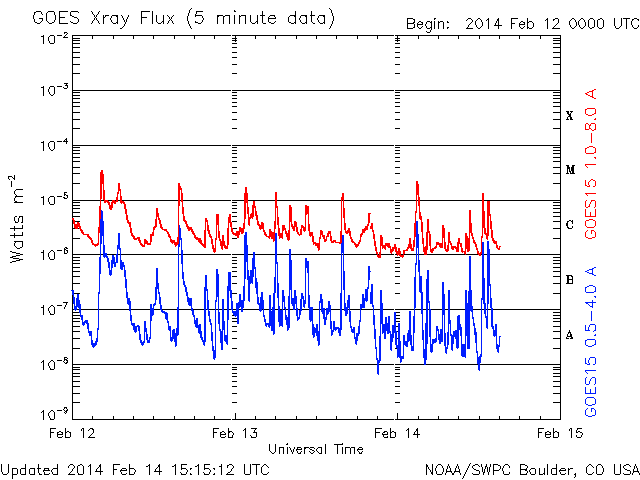Space Weather Alert - 14 February 2014
What Has Happened?
A combination of events on the Sun is expected to lead to an increase in geomagnetic activity over the weekend.
Two Coronal Mass Ejections (CME) left the Sun on Tuesday, one Wednesday and a fourth on Thursday this week. One of the CMEs on Tuesday was caused by an erupting solar filament, the other three were associated with M-class X-ray flares. Individually, none of these CMEs might be expected to greatly increase geomagnetic activity. However, their anticipated arrivals close together in the next 48 hours could mean a good chance of geomagnetic storm periods occurring throughout the weekend and into Monday.
Assuming clear dark skies, there is an increased chance of seeing the aurora in the hours following the arrival of the CMEs, particularly at high latitudes in the North of Scotland.
Sign-up to receive Geomagnetic Disturbance Alert emails.
Follow us on Twitter:
Follow @BGSauroraAlert for more occasional aurora alerts.
Follow @BGSspaceWeather for daily space weather forecasts.
Glossary
- BGS
- The British Geological Survey is one of the Natural Environment Research Council's Research Centres.
CME or Coronal Mass Ejection- The eruption of a portion of the outer atmosphere of the Sun into space, caused by rapid changes in its magnetic field. Often occurs along with a solar flare.
- Filament Eruption
- An eruption of solar plasma (i.e. ions and electrons) associated with the upward movement of solar magnetic field lines into the corona. Filaments are usually dark against the bright solar disk but can appear bright (as 'erupting prominences') on the limbs of the Sun against the darkness of space. Filaments are often associated with CMEs.
- Flare
- Energy released by the explosive reorganisation of magnetic fields within the Sun's atmosphere.
Solar Wind- The ever-present expansion of the Sun’s hot outer atmosphere into the solar system, which carries space weather within it.
Sunspot- A region of intense magnetic field in the Sun's visible outer atmosphere often associated with flares and CMEs.


